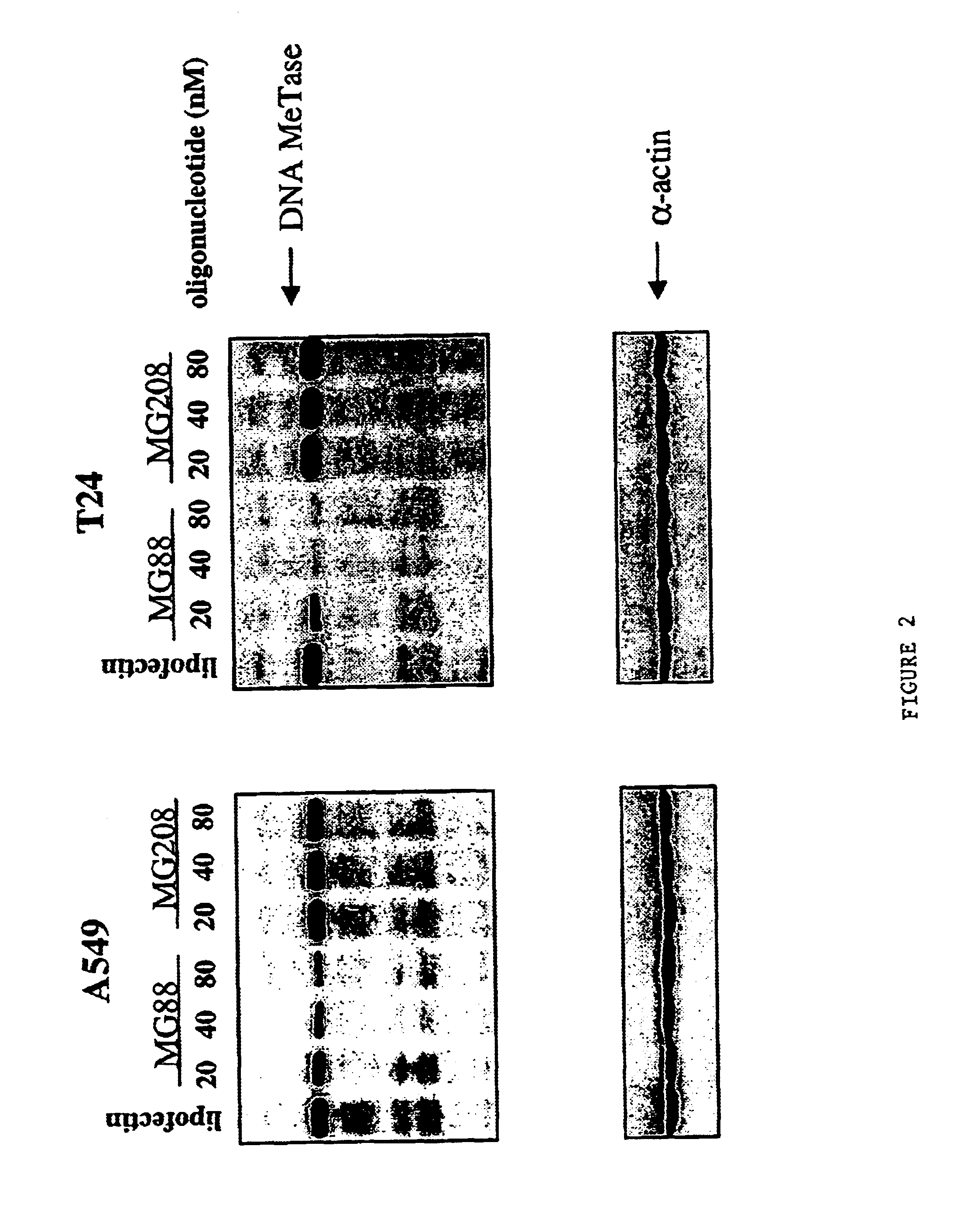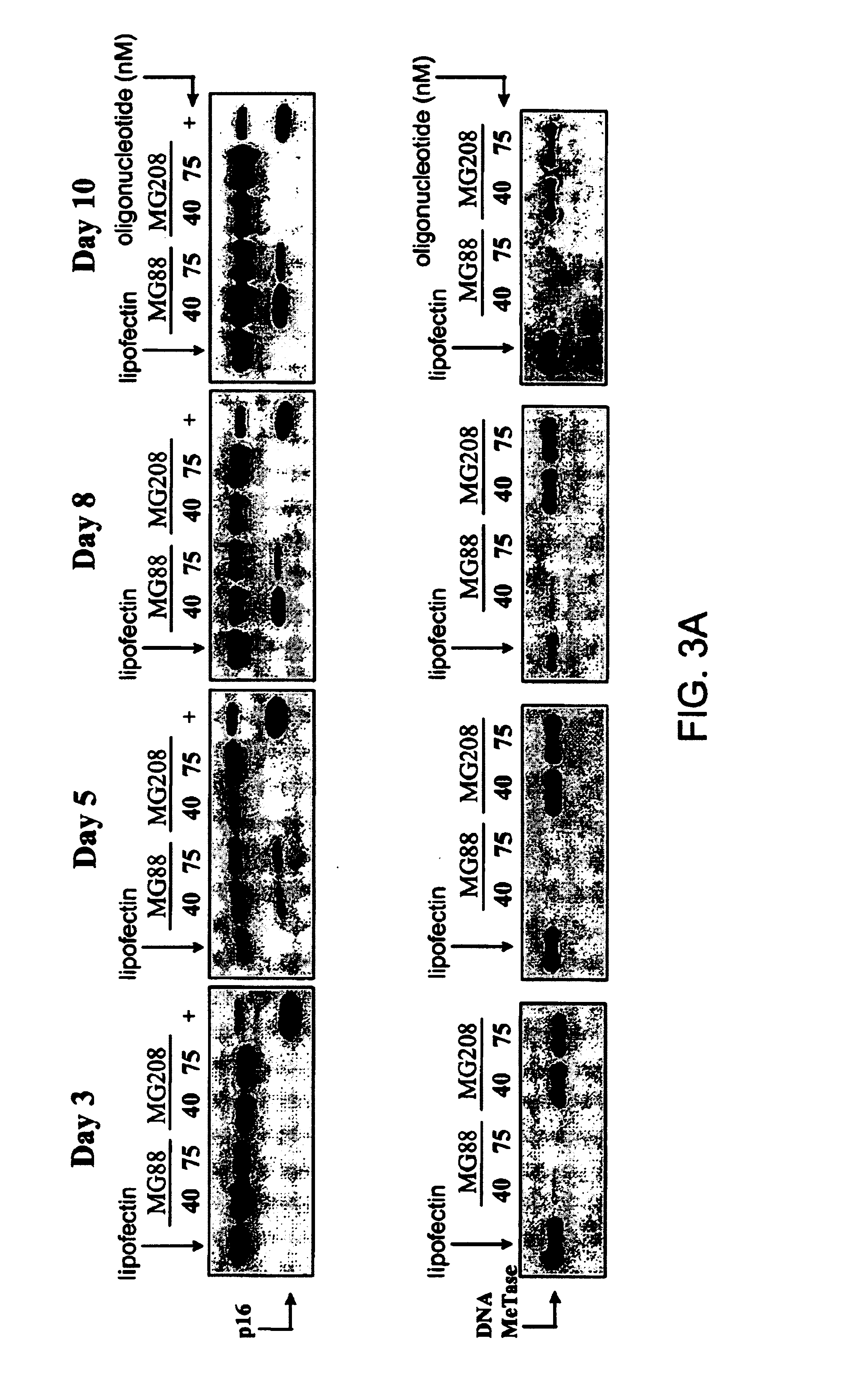Modulation of gene expression by combination therapy
a gene expression and combination therapy technology, applied in the field of gene expression modulation, can solve the problems of therapeutically deficient, large disagreement as to the mechanism involved, and the investigation of the role of methylation lies in the deficiencies of available methods for modulating methylation itself, so as to reduce doses, modulate methylation levels, and inhibit gene expression
- Summary
- Abstract
- Description
- Claims
- Application Information
AI Technical Summary
Benefits of technology
Problems solved by technology
Method used
Image
Examples
example 1
Selection of Antisense Oligonucleotides Capable of Inhibiting MeTase Expression in Neoplastic cells
[0133]To identify antisense oligodeoxynucleotides capable of inhibiting DNA MeTase gene expression in human neoplastic cells, 85 phosphorothioate oligodeoxynucleotides (each 20 base pairs in length) bearing sequences complimentary to the 5′ and 3′ regions of human DNA MeTase mRNA and sequences complimentary to intron-exon boundaries were synthesized and screened for antisense activity. As shown in FIG. 1 the two DNA MeTase mRNA regions were identified to be highly sensitive to antisense inhibition were targeted by MG88 having the sequence 5′-AAGCAT GAG CAC CGT TCUCC-3′ (SEQ ID NO:1) (this oligonucleotide is targeted to the DNA MeTase mRNA 5′UTR at nucleotides 532 to 513) and MG98 having the sequence 5′-UUCATG TCA GCC AAG GCC AC-3′ (SEQ ID NO:2) (this oligonucleotide is targeted to the DNA MeTase mRNA 3′UTR at nucleotides 5218 to 5199). These oligonucleotides were chemically modified as...
example 2
Inhibition of the p16 Tumor Suppressor by targeting DNA MeTase
[0136]The cyclin-dependent kinase inhibitor (CDKI) p16ink4A regulates the transition from G1 to S-phases of the cell cycle (Serrano et al. (1993) Nature 366: 704-707). Inactivation of p16ink4A is one of the most frequently observed abnormalities in human cancer (Serrano et al., supra). Transcriptional inactivation and associated hypermethylation of the p16ink4A promote region have also been observed in virtually all types of cancer (Gonzales-Zulueta et al. (1995) Cancer Res. 55: 4531-4535; Merlo et al. (1995) Nat. Med. 7: 686-692; Costello et al. (1996) Cancer Res. 56: 2405-2410; Lo et al., Cancer Res. 56: 2721-2725). To investigate the effect of specifically reducing cellular DNA MeTase levels on the expression and methylation status of a silenced p16ink4A gene, T24 human bladder cancer cells that contain a hypermethylated and silenced p16ink4A gene were transfected with 40 nM or 75 nM MG88 or control oligonucleotide MG2...
example 3
Inhibition of MeTase Rapidly Induces p21WAF1
[0143]Another member of the cyclin-dependent kinase inhibitor (CDKI) family, p21WAF1, inhibits a wide range of cyclin / CDK complexes involved in G1 and S phase progression (Tam et al. (1994) Cancer Res. 54: 5816-5820; Baghdassarian and French (1996) Hematol. Cell Ther. 88: 313-323; Gotz et al. (1996) Oncogene 13: 391-398). To investigate whether DNA MeTase and p21WAF1 protein levels are linked by a regulatory pathway, p21WAF1 protein levels were measured in T24 cells in which DNA MeTase levels had been incrementally reduced by MG88 treatment. To do this, DNA MeTase, p21WAF1, and α-actin protein levels were measured by Western blotting analysis in T24 cells that had been treated for either 24 hours (i.e., one 4 hour transfection time) or 48 hours (i.e., two 5 hour transfections 24 hours apart) with either 40 nM or 75 nM of either MG88 or MG208. As shown in FIG. 10A, p21WAF1 increased directly with the reduction in DNA MeTase, while neither ...
PUM
| Property | Measurement | Unit |
|---|---|---|
| Length | aaaaa | aaaaa |
| Gene expression profile | aaaaa | aaaaa |
Abstract
Description
Claims
Application Information
 Login to View More
Login to View More - R&D
- Intellectual Property
- Life Sciences
- Materials
- Tech Scout
- Unparalleled Data Quality
- Higher Quality Content
- 60% Fewer Hallucinations
Browse by: Latest US Patents, China's latest patents, Technical Efficacy Thesaurus, Application Domain, Technology Topic, Popular Technical Reports.
© 2025 PatSnap. All rights reserved.Legal|Privacy policy|Modern Slavery Act Transparency Statement|Sitemap|About US| Contact US: help@patsnap.com



